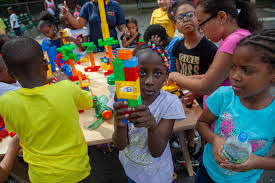Activity-based learning is a method of teaching children that is centered around hands-on, interactive activities. This type of learning is designed to engage children in a way that traditional, lecture-based teaching methods cannot. Instead of simply listening to a teacher talk, children are encouraged to actively participate in the learning process. Using their own hands and minds to explore and discover new concepts.
There are many benefits to activity-based learning for children. For one, it helps children to develop critical thinking skills. When children are actively engaged in a task, they are forced to use their problem-solving abilities to figure out how to complete it. This helps them to develop their ability to think critically and independently, which is an essential skill for success in life.
Another benefit of activity-based learning is that it helps children to stay engaged in the learning process. When children are simply listening to a teacher talk, they can easily become bored and disengaged. But when they are actively participating in a task, they are much more likely to stay engaged and focused on the task at hand. This can lead to better learning outcomes and a more positive experience for the child.
Additionally, activity-based learning can help children to develop social skills. When children are working on a task together, they are forced to communicate and collaborate with one another. This can help them to develop important social skills, such as teamwork, communication, and cooperation.
Activity-based learning is a valuable method of teaching children that can help them to develop critical thinking skills.And stay engaged in the learning process, and develop social skills. As a parent or teacher, it is important to incorporate activity-based learning into your child's education to help them reach their full potential.
Types of activity based learning:
Activity-based learning is a method of teaching that centers around hands-on, interactive activities. This type of learning is designed to engage children in a way that traditional, lecture-based teaching methods cannot. There are many different types of activity-based learning, each with their own unique benefits.
Project-based learning: This type of activity-based learning involves children working on a long-term project that requires them to use a variety of skills and knowledge. Projects can be anything from building a model of a volcano to creating a podcast about a historical event. This type of learning allows children to take ownership of their learning and apply what they have learned in a real-world context.
Inquiry-based learning: This type of activity-based learning encourages children to ask questions and explore the world around them. Children are given a question or problem to solve and are given the freedom to explore and discover the answer on their own. This type of learning allows children to develop critical thinking skills and become independent learners.
Game-based learning: This type of activity-based learning uses games as a way to teach children new concepts. Games can be anything from board games to video games and can be used to teach subjects like math, science, and history. Game-based learning is an engaging way to teach children and allows them to have fun while they learn.
Outdoor learning: This type of activity-based learning takes place outside the classroom. Children are given the opportunity to explore and learn about the natural world. Outdoor learning can include activities such as nature walks, gardening, and outdoor science experiments. It allows children to develop a deeper understanding of the environment and to appreciate the beauty of nature.
Role-playing: This type of activity-based learning involves children acting out different scenarios or roles. This type of learning allows children to develop empathy and understanding, and it allows them to see things from different perspectives.
Effect of activity-based learning on children
Activity-based learning is a method of teaching that focuses on hands-on, interactive activities to engage children in the learning process. This type of learning has been shown to have a positive impact on children's development and learning outcomes.
Increased engagement: Activity-based learning allows children to be actively involved in the learning process. Which increases their engagement and motivation. When children are engaged in the task, they are more likely to stay focused and retain the information they are learning.
Develop critical thinking skills: Activity-based learning encourages children to use their problem-solving abilities to complete tasks. This helps them to develop critical thinking skills and to become independent learners.
Improved social skills: Activity-based learning often involves children working in groups. This helps children to develop important social skills such as teamwork, communication, and cooperation.
Greater understanding of concepts: Hands-on activities allow children to experience the concepts they are learning in a tangible way. This helps them to understand the material better and to retain the information longer.
Increased self-esteem: When children are actively involved in the learning process, they are more likely to feel a sense of accomplishment. This can be helpful in improving their self-esteem and confidence.
Better Learning Outcomes: Activity-based learning is considered to be one of the most effective ways of teaching children. As it leads to better learning outcomes and a more positive experience for the child.
must-read ➤How to Cope with Children Stress
Activity-based learning is an effective method of teaching that can have a positive impact on children's development and learning outcomes. It is an engaging, interactive way to teach children that helps to increase their engagement, critical thinking skills, social skills, and understanding of concepts. It also helps to boost children's self-esteem and confidence, leading to better learning outcomes. As a parent or teacher, it is important to incorporate activity-based learning into your child's education to help them reach their full potential.
.jpeg)
.jpg)
.jpeg)

